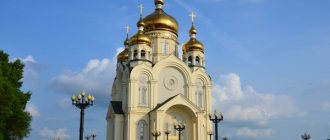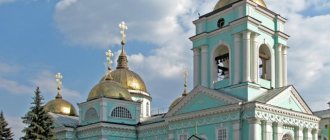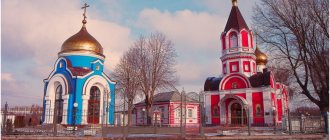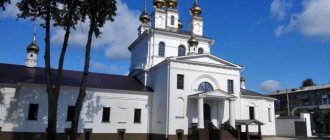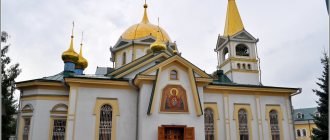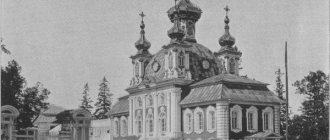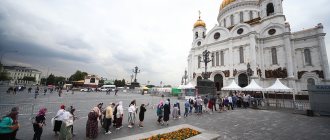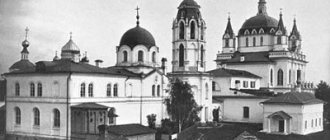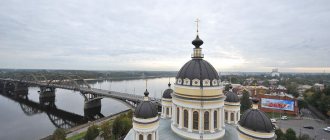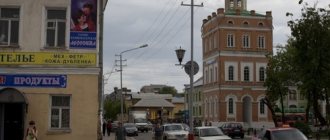In the 90s, one of the results of perestroika was the return of the Transfiguration Cathedral to Belgorod believers. This event marked the beginning of the revival of one of the largest spiritual centers in Russia. Today, the clergy of the cathedral are carrying out extensive work on the religious education of parishioners, which is so necessary after many decades of the dominance of atheistic propaganda.
Wooden Transfiguration Church
The predecessor of the current Transfiguration Cathedral in Belgorod was a wooden church, consecrated in honor of the great church holiday, the Transfiguration of the Lord. According to researchers, it was located on the territory of the Old City, called the Nogai side, as evidenced by entries in the Scribe books, the earliest of which dates back to 1626.
From the same source it is known that her clergyman owned very extensive land plots located on the opposite bank of the Seversky Donets. He owned not only arable plots, but also rich fishing grounds. This church survived even after in 1646, due to the construction of new defensive structures, the city was moved to the right bank of the Seversky Donets.
Moscow Patriarchate Belgorod Metropolitanate
With the blessing of His Eminence John, Metropolitan of Belgorod and Stary Oskol
The Ladder Theater presented a new work, “Mother’s Cross,” for the 75th anniversary of the Great Victory
The Ladder Theater showed a new work - the play "Mother's Cross" about the front-line fate of a resident of Belgorod.
On the Feast of the Transfiguration of the Lord, hundreds of Belgorod residents united in prayer
On the day of the patronal feast of the Transfiguration of the Lord, the Divine Liturgy was performed by Metropolitan John of Belgorod and Stary Oskol. At the end of the Liturgy, a religious procession took place with the relics of St. Joasaph of Belgorod.
Certificates of completion of three-year theological courses were received by students of the Sisters of Mercy Department of the Medical College of the BelSU National Research University.
15 students completed 3-year theological courses and received initial theological education.
“Legends of Vardzia” - the premiere of the play about Queen Tamara took place
The Ladder Theater delighted the audience with the premiere of “The Legend of Vardzia,” which tells the story of the life of the holy Georgian queen Tamara.
Cathedral clergy received liturgical and hierarchical awards for Easter
Archpriest Anatoly Triger was awarded the right to serve the Divine Liturgy with the Royal Doors open according to “Izhe Cherubim. » inclusive. Archpriest Georgy Vlasenko was awarded the right to wear a cross with decorations
Good initiative
Not far from it there was another, also wooden, St. Elias Church. When by the beginning of the 19th century both of them were very dilapidated and were subject to demolition, on the initiative of the local mayor I.P. Leontyev, it was decided to build one stone one instead of two wooden churches. He chose a suitable location for the future construction on Bazarnaya Square, not far from Kurskaya Street, which today bears the name of Popov. This is how the idea of creating the Transfiguration Cathedral in Belgorod was born.
Any good undertaking, and especially such a grandiose one as the construction of God’s temple, requires a material base. In this regard, a fundraiser was announced, in which all residents of the area took part. As has been the custom in Rus' since ancient times, along with representatives of the wealthy strata of the population ─ the nobility and merchants, donations were made for charitable causes even by those who had to sacrifice their last penny for this.
Temple-monument
When, finally, the necessary amount was collected, they became concerned with creating a project for the future cathedral, the work on which was entrusted to the Kharkov architect Evgeniy Alekseevich Vasiliev. Although he was young, he was already a well-established architect. Suffice it to say that at one time the future creator of the Transfiguration Cathedral in Belgorod learned the secrets of craftsmanship in a workshop led by the best St. Petersburg teacher D. Kvarneghi, the author of many sensational projects at that time.
Since the construction and decoration of the Transfiguration Cathedral (address: Belgorod, Preobrazhenskaya St., 63-B) was completed in 1813, it was decided to dedicate it to Russia’s victory over the Napoleonic army. The tradition of erecting monumental churches has a long history in our country, and therefore such a patriotic idea was met with universal approval.
Throughout the 19th and early 20th centuries, the Transfiguration Cathedral, although not a cathedral, was one of the first in the city in terms of the number of parishioners. A two-year parochial school was constantly operating under him, as well as several educational workshops, in which children from the poorest families could gain skills in some crafts. It is characteristic that, according to documents preserved in the city archive, the cathedral clergy did not receive a salary from the diocesan authorities, and for its maintenance had some auxiliary trades, including trading shops that were rented out.
Temples of the Belgorod region City of Belgorod
Transfiguration Cathedral
Address:
308000, Belgorod, st.
Preobrazhenskaya, 63-V. Phone:
, 32-44-06, 33-68-25.
Rector:
Archpriest Oleg Nikolaevich Kobets.
The clergy of the temple:
Archpriest Nikolai Gerasimovich Kobets, Archpriest Boris Vladimirovich Lavrushin, Archpriest Viktor Ivanovich Kravets, Archpriest Viktor Aleksandrovich Tolstikov, Priest Alexy Sergeevich Kurenkov, Priest Dimitry Vladimirovich Karpenko, Priest Andrei Igorevich Khvylya-Olinter, Protodeacon Igor Evgenievich Pankratov, di Akon Vladimir Olegovich Timofeev, Deacon Alexy Alexandrovich Makhonin.
The Church of the Transfiguration of the Lord was built at the expense of parishioners on the site of a dilapidated wooden church in 1813. Architect - Evgeny Alekseevich Vasiliev. (According to his designs, the university temple and the bell tower of the Assumption Cathedral in Kharkov were erected). At the beginning of the 20th century, the parish of the temple numbered 186 townspeople. There was a two-class parochial school at the temple. At the end of the 20s of the XX century, after the closure of the Holy Trinity Cathedral, the Transfiguration Church received the status of a cathedral. But in 1962, it was also among the temples subject to closure. The temple building was transferred to the regional museum of local lore.
In 1990, Divine services began in the Ilyinsky chapel. The cathedral was completely returned to the Church in July 1991.
In September 1991, the relics of St. Joasaph, Bishop of Belgorod, wonderworker (1705-1754), were transferred to the Transfiguration Cathedral, which today are the main shrine of the Belgorod and Stary Oskol diocese. On September 17, 1911, according to the Decree of the Holy Synod, approved by Emperor Nicholas II, Bishop Joasaph was glorified as a saint and his miraculous relics were found. Until December 1920, the holy relics rested in the Holy Trinity Cathedral in the city of Belgorod. At this time, they were opened by the Bolsheviks and sent first to Kursk for several months, then to Moscow, to the People's Commissariat of Land Museum.
But it became “dangerous” to leave the incorrupt relics of St. Joasaph of Belgorod in Moscow. Crowds of pilgrims came to them to venerate. The relics were urgently taken to Leningrad, to the Kazan Cathedral. (At that time the cathedral housed a museum of religion and atheism). At first, they tried to display the relics in the northern aisle of the cathedral - opposite the grave of M.I. Kutuzova. But then Moscow history repeated itself exactly. In 1970, the director of the Leningrad Museum of Religion and Atheism received instructions to remove the existing relics from the museum. But the museum workers Arkady Vasilyevich Sokolov and Vladimir Ivanovich Prudnikov decided to hide the relics of St. Joasaph in the attic of the Kazan Cathedral.
They kept this fact in the strictest confidence for more than twenty years. And only in 1991 the secret was revealed by Arkady Vasilyevich to his daughter. In the same year, the newly acquired relics, after identification, were brought to Moscow, where they were kept in the Patriarchal Epiphany Cathedral until September. Then the reliquary with the incorruptible relics was transported to Kursk. And exactly eighty years after the canonization of the Belgorod saint by the Orthodox Church, his relics returned to his throne city.
Since the mid-1990s. a new pious tradition has been established in the diocese: annually on August 19, on the feast of the Transfiguration of the Lord, the relics of St. Joasaph are transferred in a procession from the Transfiguration Cathedral to the St. Nicholas Cathedral, where they remain until September 16, when, after Little Vespers with an akathist, they are transferred in a procession to the Transfiguration Cathedral Cathedral. An all-night vigil is held there. On September 17, the day of glorification (1911) and the second discovery of the relics of the saint, three Divine Liturgies are celebrated in the cathedral on three altars (at 3 a.m., 6 a.m. and 9 a.m. - by the bishop's service) and a prayer service at the relics of the saint. An all-night vigil, three Divine Liturgies and a prayer service are celebrated in the cathedral also on December 23, the day of the saint’s repose (1754).
See also: Borovsk Cathedral
A particularly revered shrine of the Transfiguration Cathedral was the miraculous icon of St. Nicholas, called “Nicholas the Ratny,” which is more than 500 years old. According to legend, she protected the residents of the Shebekin village of Ustinka from an attack by Mongol-Tatar troops. Seeing the enemy, the inhabitants of the Nicholas Hermitage, located in the village, came out to meet him with an icon of St. Nicholas the Wonderworker. The Tatars crossing the river, seeing the religious procession, stopped, began to crowd together and fall from the dam into the water. The rest of the army turned back. There was a story about the case of a bloodless, unprecedented victory in every pre-revolutionary edition of the reference book “Orthodox Shrines”. Currently, every year in May, a procession of the cross from Belgorod to the village of Ustinka is carried out with the icon of “Nicholas the Ratnoy”.
Another shrine of the Transfiguration Cathedral is the icon of the Mother of God “The Sign”. This icon was made at the beginning of the 20th century. The icon was presented as a museum exhibit at an exhibition dedicated to the life and works of St. Joasaph. On one of the days of the exhibition, museum staff noticed that the faces of the Mother of God and the Infant were becoming brighter. The museum’s management decided to transfer the unusual icon to the Transfiguration Cathedral. This happened in early December 1998. The cathedral is an architectural monument built in the style of Russian classicism. One of two five-domed churches preserved in Belgorod.
Troubled times
When, after the October revolution, a wave of anti-religious campaigns swept across Russia and thousands of churches were closed or taken away from believers, and then desecrated by inappropriate use, parishioners of the Transfiguration Cathedral in Belgorod managed to preserve their shrine for a long time. Now it’s even difficult to imagine what enormous efforts and sacrifices this cost. Nevertheless, the cathedral survived, and in 1925 it even became a cathedral after the closure of the Church of the Holy Trinity, which had this status for many years.
At the end of the 20s, there were repeated attempts to close the cathedral. The reason for this was another, and this time especially large-scale, wave of anti-religious campaigns. In the city museum you can now see a yellowed issue of the newspaper “Belgorodskaya Pravda” for 1929, in which the author of the editorial addressed the party and economic authorities with an appeal to close the Transfiguration Cathedral in Belgorod, and convert its building into a grain storage facility. However, the city authorities never decided to take this step, and the cathedral continued to operate for more than three decades.
Cathedral turned into a museum
The main city shrine was closed only in 1962, when Khrushchev demanded that local party bodies tighten the fight against “religious dope” - as was the customary saying in those years. However, the cathedral building, fortunately, was not demolished and converted into industrial or warehouse premises. A regional local history museum was created there, which saved the architectural monument from destruction.
Since the cathedral was quite impressive in size, local historians were able to place an exhibition consisting of 4.5 thousand exhibits in sixteen halls into which its internal volume was divided. It was located on two floors and occupied an area of 1116 m². They even tried to open a planetarium in the domed part, but this remained only in projects.
Revival of the shrine
When the winds of perestroika blew in the country at the end of the 80s and the state’s attitude towards the church changed, the changes also affected the Transfiguration Cathedral in Belgorod. In 1990, it was returned to believers, after which restoration and restoration work began, funds for which, as in previous times, were collected by the whole world.
Then its consecration took place. In September of the following year, a very significant event took place: with the gathering of several thousand believers, the relics of St. Josaphat of Belgorod, the second discovery of which had occurred shortly before, were transferred in a procession of the cross.
Spaso-Preobrazhensky Cathedral in Belgorod
The temple, consecrated in honor of the Transfiguration of the Lord, existed in Belgorod since the 16th century in the area of modern Cathedral Square. By the beginning of the 19th century, the wooden building began to pose a danger to parishioners. And the nearby Elias Church could not accommodate believers from both parishes. In 1805, city and church authorities decided to build a new religious building.
Construction of the temple began in 1807. Six years later, on the day of the Transfiguration of the Lord, it was consecrated. Until the middle of the 19th century, it was called by three main aisles - Preobrazhensko-Ilyinsky-Alexandro Nevsky. By the beginning of the 20th century. The monumental building was reconstructed twice and supplemented with decorative facade elements.
Changes in the political and social life of the country brought changes to its religious component. The authorities of Belgorod listened to the requests of the population to return the Transfiguration Cathedral to believers. In 1990, an official decision was made to gradually transfer the building to the Orthodox Church.
More interesting articles about Orthodoxy:
In August 1991, the second discovery of the relics of St. Joseph of Belgorod took place, which were transferred to the Church by the Leningrad Museum of Religion. In the presence of Patriarch Alexy II, the shrine was solemnly transferred to the Transfiguration Cathedral. From this moment begins a long journey of revival of the church, which required updating the appearance and complete reconstruction of the interior.
The interior design of the main temple of Belgorod is distinguished by its pomp and decorativeness. The walls and vaults are covered with paintings depicting holy celestials and biblical scenes. The large and small iconostases, icon cases, and the canopy over the shrine with holy relics are covered with gilded carvings made in the Baroque style. The central iconostasis consists of three tiers. In the main part of the building, on the second floor level, there is a room for the choir.
See also: Cathedral copy of St. Basil's
Schedule of services
Divine services in the Transfiguration Cathedral are held daily according to the following schedule:
On general church and patronal holidays, changes in the work of the church are possible, information about which should be clarified in the parish information service. The following holidays are celebrated with special pomp:
Today, the Church of the Transfiguration of the Lord, considered an architectural monument, is one of the centers of spiritual and social life in Belgorod. Active educational activities are carried out on its basis.
The city on a white chalk mountain rising above the Seversky Donets River is one of the centers of Russian Orthodoxy. Over the centuries-old history, many majestic and beautiful churches were erected on Belgorod soil, many of which have survived to this day. One of the most interesting and dramatic is the fate of the Transfiguration Cathedral.
History of construction
During its existence, the Transfiguration Church, together with the city of Belgorod, experienced periods of both prosperity and decline, going from a parish church to a cathedral.
For two years, preparatory work was carried out, consisting of the following:
During the years of tsarist power, the Transfiguration Cathedral performed parish functions. But his quiet life ended after the Bolshevik revolution. In the early 20s. church property was confiscated. In 1923 it became the main temple of the city. The Transfiguration Cathedral was closed in 1934 by decision of the Belgorod City Council.
In 1942, the occupying German government allowed the church to reopen. It was not closed after the liberation of the city, but was transferred to the Orthodox community. But in the wake of new anti-religious protests by the Soviet leadership in 1962, the religious building was transferred to the local history museum. In order to adapt the interior spaces for exhibition halls and storage facilities, it was necessary to carry out reconstruction, which lasted more than 10 years. The museum, housed in a church, opened its doors only in 1973.
Renaissance
Architecture
Interesting: during its existence, the church changed its color several times. Initially, its walls were covered with simple white whitewash. In Soviet times, they were painted in various shades of green. Modern facades dazzle with bright turquoise color and white decorative details.
The cathedral is located at the address: Belgorod, st. Preobrazhenskaya, 63.
Patronal holidays
Activities of the parish
In addition to divine services, the clergy of the Transfiguration Church conduct active educational and outreach work with children and adults in the city of Belgorod. At the parish there is an educational and methodological department, on the basis of which work is organized in the following areas:
Soviet time
This process began with the chapel in honor of Elijah the Prophet, the first service of which took place in September of the same year. The completion of the transfer of all premises of the building was planned for 1993. But in August of the following year, an event occurred that significantly accelerated the process.
The Transfiguration Cathedral was built in the style of Russian classicism. The building has a cross-domed plan and consists of three main parts:
- on weekdays two services are held at 8.00 and 17.00;
- from Monday to Friday at 13.00 they read an akathist to Saint Joseph of Belgorod;
- on Saturday and Sunday there are two morning services (7.30 and 9.30) and an evening prayer service at 17.00.
- August 2 is the day of Elijah the Prophet;
- December 10 – icon of the Mother of God “The Sign”;
- classes with children from 6 to 16 years old in Sunday school;
- organizing performances by the Ladder children's theater, whose repertoire includes performances of a religious nature;
The Transfiguration Cathedral is a majestic architectural monument that is the center of the spiritual life of Belgorod. Even during the times of the God-fighting Soviet rule, with its majestic appearance it instilled reverence in the souls of people for the House of the Lord.
Services in the Transfiguration Cathedral (Belgorod)
Today, the church has a religious library, a Sunday school, a teaching room, catechism courses and the Ladder musical theater. But, in addition, all services provided for by the Charter of the Russian Orthodox Church are performed in full. The schedule of services in the Transfiguration Cathedral in Belgorod is as follows: from Monday to Saturday morning services, including liturgy, begin at 8:00, and on Sundays they take place at 8:30 and 9:30; Evening services, both on weekdays and on holidays, begin at 17:00.
Cathedral of the Transfiguration in Belgorod
"Save me, God!". Thank you for visiting our website, before you start studying the information, please subscribe to our Orthodox community on Instagram, Lord, Save and Preserve † - https://www.instagram.com/spasi.gospodi/. The community has more than 44,000 subscribers.
There are many of us like-minded people and we are growing quickly, we post prayers, sayings of saints, prayer requests, and timely post useful information about holidays and Orthodox events. Subscribe. Guardian Angel to you!
Belgorod has a large number of ancient Cathedrals and temples. But the Transfiguration Cathedral of Belgorod deserves special attention . It has its own history and secrets. Despite its “age,” it attracts more and more parishioners every day. This is not in vain, because it contains many miraculous images.
History of construction
According to historical facts, the temple was first mentioned in the 16th century. As described in the Chronicles, the temple would be rich in various holy faces and other church churches. Many historians are of the opinion that it was built in honor of the victory during the war with Napoleon’s army.
On the site where the temple was first built there used to be an old and dilapidated church. The newly built Transfiguration Church was a two-story building made of brick and stone. He had three limits. At a time when the Bolsheviks were fighting against the Orthodox religion on the territory of the USSR, the temple was closed, like many others.
After its closure, it housed a local history museum. And only in the early 90s the building was returned to its original purpose. After which some work was carried out to restore it. In 1991, the first Divine Liturgy was held in the Cathedral.
Shrines
As mentioned above, there are many shrines in the temple. The main ones are the following:
- relics of Saint Joseph the Wonderworker,
- Holy Face of Our Lady of the Sign,
- image of St. Nicholas the Ratnoy.
- On weekdays, Liturgies are read at 7:00 and 19:00.
- On weekends, morning services begin at 6:30 on Saturday and 7:00 on Sunday, and evening services on Saturday at 17:00, and on Sunday at 18:00.
Parishioners simply fly in from all over the country to pray and bow before the saints. There are stories about them throughout the country about how icons helped many people in the most difficult everyday situations. There is a two-class Sunday school at the temple, where they study the holy letter, chants, etc.
See also: 8th Ecumenical Council preparation
It should be noted that today the Transfiguration Cathedral is considered an architectural monument. But despite this, Divine Liturgies are held there daily. Every year, at the end of each spring, a crusade procession to the neighboring village of Ustinka takes place with the icon of St. Mother of God “The Sign”.
Schedule of services of the Transfiguration Cathedral in Belgorod
Divine Liturgies are still held in the Orthodox church to this day. All Orthodox believers can visit them. The cathedral is open every day, seven days a week. Worship services are held according to the following schedule:
On holidays, the schedule of services is slightly different. More precise starting times for Liturgies on holidays can be obtained from the clergy of the Cathedral itself.
The exact address of the Transfiguration Cathedral in Belgorod: Belgorod. St. Preobrazhenskaya house 63 century.
It is convenient to get to it both by public transport and by your own car. It is so famous that every resident can tell you the shortest route to the temple.
